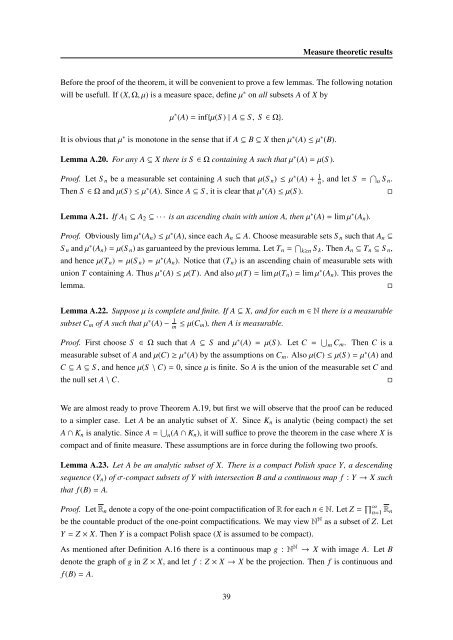Disintegration theory for von Neumann algebras
Disintegration theory for von Neumann algebras
Disintegration theory for von Neumann algebras
You also want an ePaper? Increase the reach of your titles
YUMPU automatically turns print PDFs into web optimized ePapers that Google loves.
Measure theoretic results<br />
Be<strong>for</strong>e the proof of the theorem, it will be convenient to prove a few lemmas. The following notation<br />
will be usefull. If (X, Ω, µ) is a measure space, define µ ∗ on all subsets A of X by<br />
µ ∗ (A) = inf{µ(S ) | A ⊆ S, S ∈ Ω}.<br />
It is obvious that µ ∗ is monotone in the sense that if A ⊆ B ⊆ X then µ ∗ (A) ≤ µ ∗ (B).<br />
Lemma A.20. For any A ⊆ X there is S ∈ Ω containing A such that µ ∗ (A) = µ(S ).<br />
Proof. Let S n be a measurable set containing A such that µ(S n ) ≤ µ ∗ (A) + 1 n , and let S = ⋂ n S n .<br />
Then S ∈ Ω and µ(S ) ≤ µ ∗ (A). Since A ⊆ S , it is clear that µ ∗ (A) ≤ µ(S ).<br />
□<br />
Lemma A.21. If A 1 ⊆ A 2 ⊆ · · · is an ascending chain with union A, then µ ∗ (A) = lim µ ∗ (A n ).<br />
Proof. Obviously lim µ ∗ (A n ) ≤ µ ∗ (A), since each A n ⊆ A. Choose measurable sets S n such that A n ⊆<br />
S n and µ ∗ (A n ) = µ(S n ) as garuanteed by the previous lemma. Let T n = ⋂ k≥n S k . Then A n ⊆ T n ⊆ S n ,<br />
and hence µ(T n ) = µ(S n ) = µ ∗ (A n ). Notice that (T n ) is an ascending chain of measurable sets with<br />
union T containing A. Thus µ ∗ (A) ≤ µ(T). And also µ(T) = lim µ(T n ) = lim µ ∗ (A n ). This proves the<br />
lemma.<br />
□<br />
Lemma A.22. Suppose µ is complete and finite. If A ⊆ X, and <strong>for</strong> each m ∈ N there is a measurable<br />
subset C m of A such that µ ∗ (A) − 1 m ≤ µ(C m), then A is measurable.<br />
Proof. First choose S ∈ Ω such that A ⊆ S and µ ∗ (A) = µ(S ). Let C = ⋃ m C m . Then C is a<br />
measurable subset of A and µ(C) ≥ µ ∗ (A) by the assumptions on C m . Also µ(C) ≤ µ(S ) = µ ∗ (A) and<br />
C ⊆ A ⊆ S , and hence µ(S \ C) = 0, since µ is finite. So A is the union of the measurable set C and<br />
the null set A \ C.<br />
□<br />
We are almost ready to prove Theorem A.19, but first we will observe that the proof can be reduced<br />
to a simpler case. Let A be an analytic subset of X. Since K n is analytic (being compact) the set<br />
A ∩ K n is analytic. Since A = ⋃ n(A ∩ K n ), it will suffice to prove the theorem in the case where X is<br />
compact and of finite measure. These assumptions are in <strong>for</strong>ce during the following two proofs.<br />
Lemma A.23. Let A be an analytic subset of X. There is a compact Polish space Y, a descending<br />
sequence (Y n ) of σ-compact subsets of Y with intersection B and a continuous map f : Y → X such<br />
that f (B) = A.<br />
Proof. Let R n denote a copy of the one-point compactification of R <strong>for</strong> each n ∈ N. Let Z = ∏ ∞<br />
n=1<br />
R n<br />
be the countable product of the one-point compactifications. We may view N N as a subset of Z. Let<br />
Y = Z × X. Then Y is a compact Polish space (X is assumed to be compact).<br />
As mentioned after Definition A.16 there is a continuous map g : N N → X with image A. Let B<br />
denote the graph of g in Z × X, and let f : Z × X → X be the projection. Then f is continuous and<br />
f (B) = A.<br />
39

















